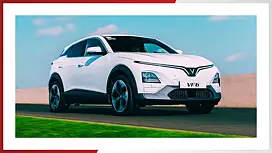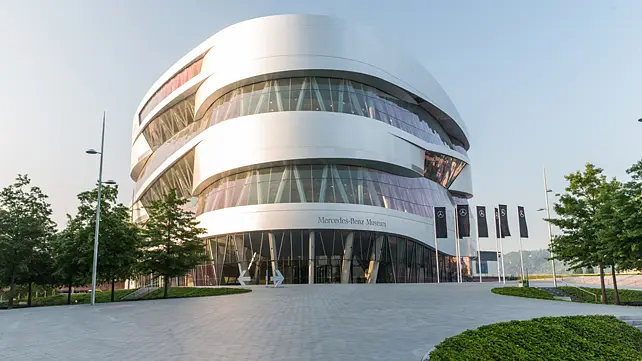
“Design creates something out of the ordinary and makes a major contribution to shaping the brand image in the public eye” – this statement used by Mercedes-Benz to define its design philosophy isn’t relevant just for its vehicles. The bipolarity of intelligence and emotion, which are fundamental to the brand, is evident also in the way the company preserves and presents its history, while also allowing a glint into the future of mobility.
We are talking about the Mercedes-Benz Museum in Stuttgart, Germany. Stuttgart, incidentally, is home to two iconic automobile brands – Daimler AG and Porsche – and is also the birthplace of leading automotive supplier, the Bosch Group, which was set-up in 1886 by Robert Bosch as a “Workshop for Precision Mechanics and Electrical Engineering.” Mahle is another large global supplier that is headquartered in Stuttgart.
The city is the capital of the state of Baden-Württemberg in southwest Germany, and lies at the centre of the historic region of Swabia. It is often referred to as the “cradle of the automobile”, as the automobile and motorcycle was invented in Stuttgart by Karl Benz in 1886. The automobile was subsequently industrialised in 1887 by Gottlieb Daimler and Wilhelm Maybach at the Daimler Motoren Gesellschaft (Daimler Motors Corporation), which they founded to manufacture engines and vehicles.
This is a trip down memory lane to the Mercedes-Benz Museum, located at Mercedesstraße, right next to the Daimler factory and a stone's throw away from the Mercedes-Benz Arena, home to the German Bundesliga (football league) club VfB Stuttgart.
From our archives, we take a look at some of the most iconic exhibits at the museum.

The museum is designed like a double helix with a clover leaf pattern. Like the exhibits it houses – 160 vehicles and over 1,500 displays – the museum itself reflects innovation in every sense. It is claimed to be the only museum in the world that can document in a single continuous timeline of about 130 years of auto industry history, right from the first product created in 1886. Designed by Dutch architect Ben van Berkel, the museum was opened in 2006. The shell of the museum is made of glass and aluminium. What is exhibited over nine floors, and 16,500 sq m area, is utter delight for not just an auto enthusiast but anyone with a remote interest in history.
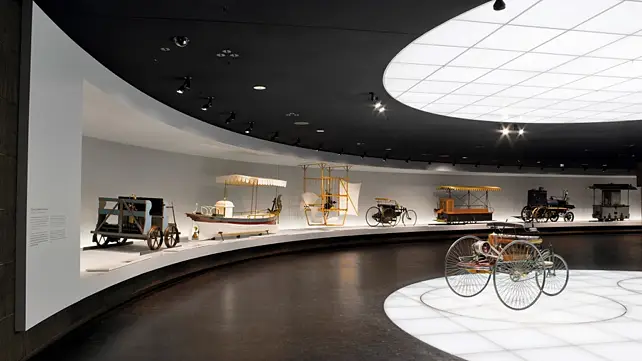
First up, you step into a lift designed like a space pod, but called a 'time machine' by the guide. The lift took us nine floors and 34 m above the ground to 1886, the year the company was born. The first exhibit you see is that of a horse, indicating – you guessed it right – one horsepower! Take a right, and you are in a legends room that chronicles the first set of automobiles ever made from 1886 through 1900.
Benz Patent Motor Car – the first automobile (1885 – 1886)
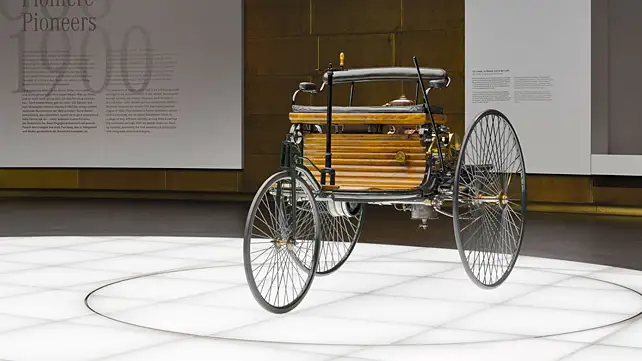
Karl Benz developed the first stationary gasoline engine – a one-cylinder, two-stroke unit – and ran that for the first time on New Year's Eve 1879, records Daimler history. In 1885, he completed his dream project of creating a lightweight, two-seater car, powered by a compact high-speed single-cylinder four-stroke gasoline engine that produced 0.75 hp of power. The engine was installed horizontally at the rear of the vehicle, which was built on a tubular steel frame, with differential and three wire-spoked wheels.
The vehicle also included an automatic intake slide, a controlled exhaust valve, high-voltage electrical vibrator ignition with spark plug, and water/thermo siphon evaporation cooling. Interestingly, this vehicle had no steering. The patent Benz received for his 'vehicle powered by a gas engine' under patent number 37435 may be regarded as the birth certificate of the automobile, notes the company.
Daimler Single-Cylinder Engine, the Grandfather Clock
Daimler's Grandfather Clock was the world's first small high-speed internal combustion engine to run on gasoline. It weighed 92 kg only, yet was powerful enough to drive a vehicle. The patent for this engine was filed in 1885. The unit shown here is a more powerful version from 1886, with a displacement of 462 cc and peak power of about 1.08 hp. The epithet 'Grandfather Clock' was given because of the way the engine looked.
Benz Victoria
Built in 1893, the Benz Victoria was Karl Benz's first four-wheeled automobile. It was a fundamentally new design, made possible by the kingpin steering system improved by Benz. The new design permitted the two front wheels to assume different cornering radii and therefore the vehicle to negotiate bends more safely. This single-cylinder, 1,726 cc engine produced about 2.96 hp at 450 rpm, and could attain a top speed of 18 km/h.
Daimler Vis-à-Vis Belt-Driven Car
The Daimler Riemenwagen, built in 1896, was the first Daimler-Motoren-Gesellschaft model to be mass produced, with about 150 of them being made. This featured a two-cylinder, 1,060 cc engine that produced 4.5 hp at 740 rpm. The Vis-à-Vis car featured three important inventions – the Phoenix engine, the spray nozzle carburettor and belt-drive.
10/40 hp Mercedes Sport-Zweisitzer (Two-Seater)
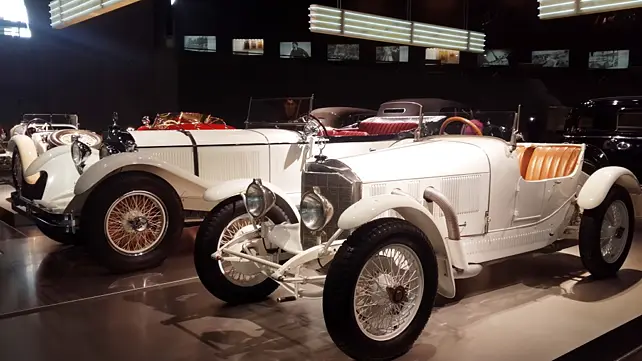
World War I had put an end to manufacturing of cars at the Daimler-Motoren-Gesellschaft. In 1923, new passenger cars – the 10/40 hp Mercedes and the 6/25 hp sister models were made. These were the world's first standard-production passenger cars with supercharged engines. The supercharger, still called 'blower' in 1923, supplied the small displacement engine with more air, thereby temporarily boosting output from 40 hp to 65 hp. These cars, featuring a four-cylinder engine, achieved top speed of 110 km/h.
Mercedes-Simplex 40 PS
The 40 hp Mercedes-Simplex is the oldest existing Mercedes today. It was the direct successor of the 35 hp Mercedes designed by Wilhelm Maybach, considered to be the first automobile of the modern age. The 'Simplex' name is related to the relative ease with which it handled for the period. This four-cylinder, 6,785 cc car was built in 1902. The engine peaked at about 1,100 rpm and achieved a top speed of 80 km/h.
Mercedes-Benz 500 K Spezial-Roadster
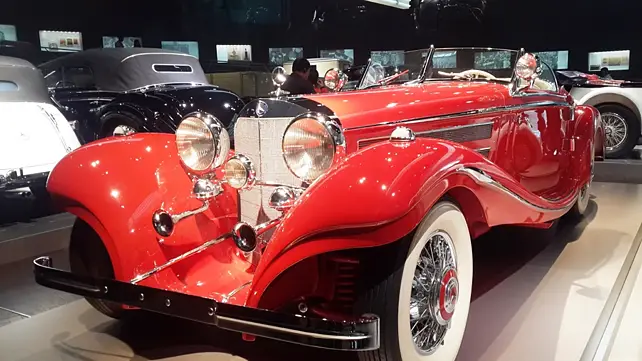
In 1936, the company made the 500 K for the rich and beautiful. Together with the representative Grand Mercedes, the elegant 500 K sports car was the brand's showpiece in the 1930s. The 500 K got eight different bodywork versions, but the special roadster version show here was the most appealing. It was powered by an eight-cylinder 5,018 cc engine that delivered approximately 100 hp (160 hp with a supercharger). Top speed was rated at 160 km/h. This car was considered the most elegant looking vehicle of that time, and at a price of about € 98,000, it was also the most expensive! In total, Mercedes-Benz produced 342 units of this car across all versions.
Mercedes-Benz 260 D Pullman-Limousine
This was the world's first diesel-engined passenger car from large scale production. This was an economical car at that point as it consumed less fuel. The four-cylinder engine with a displacement of 2,545 cc peaked at about 45 hp. In the Pullman sedan version, the 260 D was the ideal taxi and also in great demand as a sedan for long distance travel. This vehicle was in production for a period between 1936 and 1940. A total of 1,967 units were made.
Mercedes-Benz 300
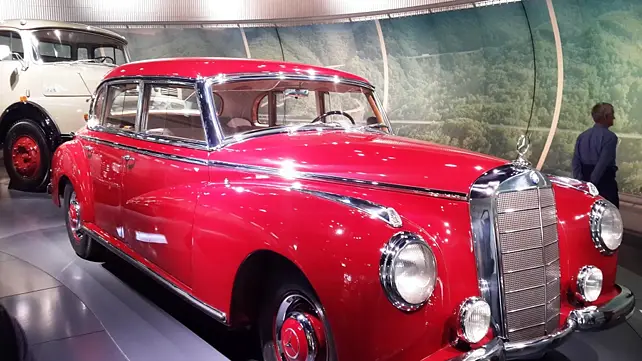
The 300 was the fastest and biggest German-built production car in 1951. It followed the tradition of the Grand Mercedes and quickly became the most important status car of the young federal republic. The 2,996 cc engine with four cylinders achieved a top speed of 160 km/h and the peak power was rated at 113 hp @ 4,600 rpm. The four-door 300 models, produced between 1951 and 1954, were often referred to as Adenauers after Konrad Adenauer, the first Chancellor of the Federal Republic of Germany.
Mercedes-Benz 300 SL Coupé
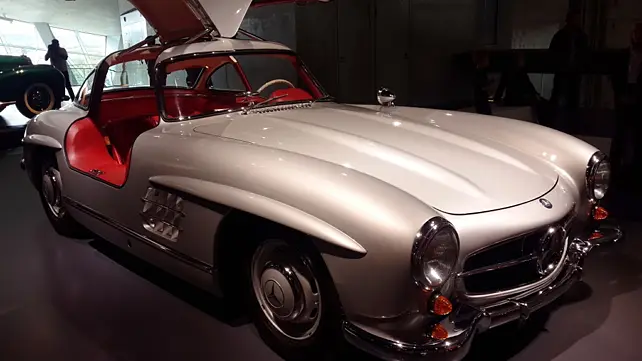
Presented in 1954, this 300 SL production sports car was based on the successful completion version of 1952. Its space frame weighed just 50 kg, but was particularly sturdy. However, the structure didn't permit fitment of normal doors because of the high frame side members. With its characteristic upward-opening doors, this dream car of the 1950s popularly became known as the Gullwing. The company produced 1,400 units of the car between 1954 and 1957. A top speed of 250 km/h, 212 hp of peak output at 5,800 rpm were some of the other core characteristics of the car.

There was a radical change in the appearance and construction of Mercedes-Benz cars in the 1950s. The three-box design with a self-supporting body, space frame and flat radiator grill were some of the hallmark features of this transition into a new era. Other changes in form and design included the cab-over-engine and short-nose designs.
Mercedes-Benz O 303 Reise-Omnibus
Mercedes-Benz introduced a series of buses in 1974, setting a new standard in comfort and safety in touring coaches. This model, the O 303 Colonia Reisen, featured a V8 engine that displaced 12,763 cc and peaked at about 252 hp. Beginning in 1980, rollover tests were performed with these buses, which eventually led to the development of rigid body skeletons for buses and coaches. This model also led the way in active safety. In 1981, it became the first bus in the world to be fitted with an ABS. This series of buses continued to be produced till 1992, with the company making 25,778 units in total.
Mercedes-Benz 190 E
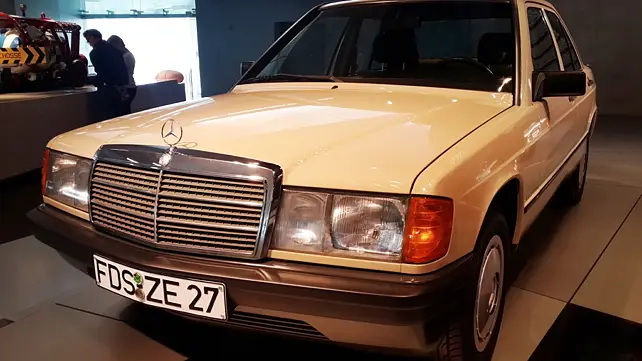
In 1982, Mercedes-Benz extended its medium-sized car range with the introduction of a third car series – the 190 and 190 E. It soon came to be known as the Baby Benz. Owing to low wind resistance and low weight, the Baby Benz consumed comparatively less fuel. Despite its compact dimensions, it was just as safe and comfortable as the larger Mercedes cars. This model from 1984, could achieve a top speed of 195 km/h, powered by a four-cylinder 1,997 cc, 120 hp engine. The company produced 638,180 units of these cars between 1982 and 1993.
Mercedes-Benz 500 SL
The gallery that houses vehicles used by celebrities and world figures offers a fascinating sight. This Mercedes-Benz 500 SL was acquired by Princess Diana, the wife of the Prince of Wales, in December 1991. She thus became the first member of the royal British family to drive a foreign car privately. However, this didn't go down well with the government, trade unions and industry in Great Britain, as a result of which she had to return the vehicle in September 1992.
Mercedes-Benz 230 G Popemobile
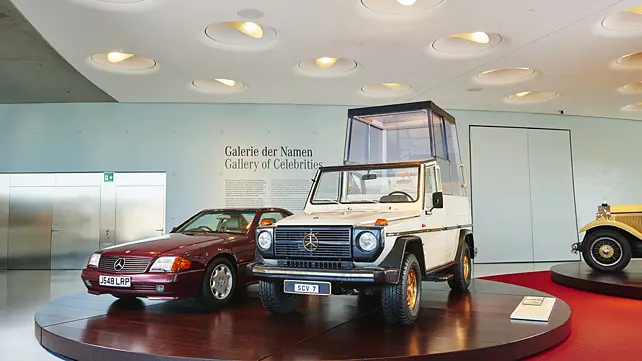
The Mercedes-Benz Museum notes that the 230 G Popemobile is perhaps the most famous Mercedes product belonging to a VIP. Built in 1980 to protect Pope John Paul II from wind and rain during his visit to Germany, the bodywork of this vehicle was furnished with bulletproof glazing following an assassination bid on him in May 1981. The custom-built unit was based on the Mercedes-Benz cross-country vehicle. Only two such units were ever built.
Mercedes-Benz 600 Pullman Staatslimousine
In 1963, Mercedes-Benz presented a new prestige car – the 600. This fully armoured state limousine with a raised roof was built in 1965 as a unique specimen for the company's own car fleet. For over 30 years, this vehicle carried Kings, Chancellors, and Presidents on state visits to Germany. The company made only two of these limousines. Also on display is a Mercedes-Benz ML 320 [W163] featured in the movie 'The Lost World: Jurassic Park'.
Mercedes-Benz C 111
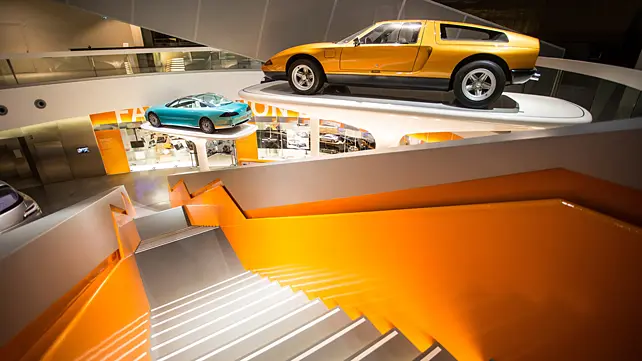
At the Frankfurt International Motor Show (IAA) in September 1969, Mercedes-Benz presented the C 111 – the 'test lab on wheels' – with its wedge-shaped body and upward-opening gullwing doors. The body consisted of fibre-glass reinforced plastic and was riveted and bonded to the steel frame-floor unit. It was also a test bed for the Wankel engine, which was a three-rotor unit, developing 280 hp, and one that achieved a top speed of 260 km/h – a remarkable feat for its time (1969). In 1970, a thoroughly revised version of the C 111 was shown at the Geneva Motor Show featuring a four-rotor Wankel engine with an output of 350 hp. The car accelerated from standstill to 100 km/h in 4.8 s and attained a top speed of 300 km/h. The record-breaking C 111-IV of 1979 came with further aerodynamic refinements, featuring distinctive spoilers, a changed front end and two tail fins. Its propulsion unit was a series-production 4.5 l V8 engine, enlarged to displace 4.8 l and to develop 500 hp. This version of the C 111-IV was no longer purely a research vehicle, but one that achieved top-class sporting performance. As such, it provided many insights that benefited series production. (Source: Daimler).
Dieselmotor
This 3 l diesel engine, fitted with an exhaust gas turbocharger, achieved an output of 115 hp. It was with this engine that in the same year, the Mercedes-Benz 300 SD (W116 series) became the first series production passenger car to feature a turbocharged diesel engine.
Mercedes-Benz 2, 5 l Rennwagen W 196 R

For the 1954 and 1955 Formula 1 seasons, Mercedes-Benz lined up two versions of the W 196 R. while the streamlined variant was selected for the high speed circuits of Reims, Berlin and Monza, the classic monoposto with open wheels got the vote for majority of the races, as it was better suited for twistier tracks. These cars had V8 engines that displaces 2,497 cc and produced about 286 hp at 8,500 rpm and clocked top speed of 275 km/h.
Mercedes-Benz B-Class Fuel Cell
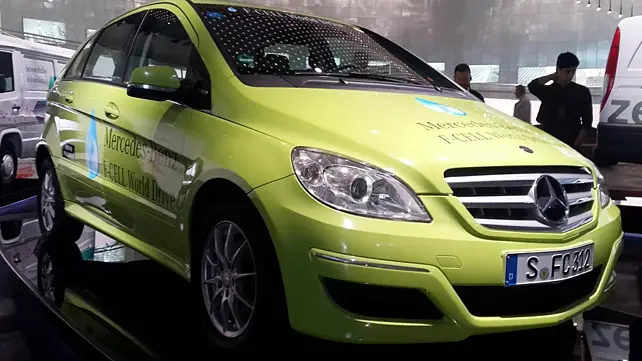
In 2010, Mercedes-Benz introduced the first series-produced electric car with fuel cell drive. The B-Class F-CELL, as the car was called, features an electric motor with a new-generation fuel cell drive that is compact, efficient, safe and fully suitable for everyday use, claims the company. The fuel cell generates the traction current on board, producing no pollutant emissions, but merely pure water. The car has a range of 400 km, achieves a top speed of 106 km/h and has a combined output of 136 hp.
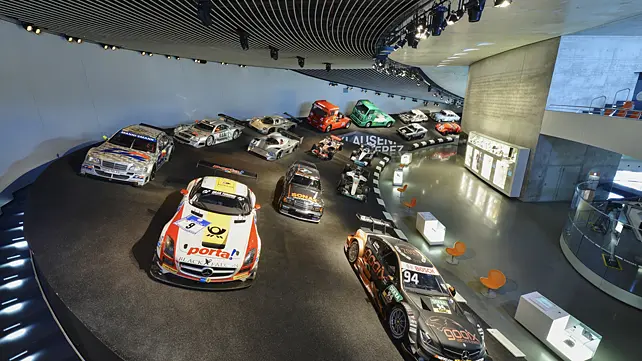
One of the floors had the whole range of Mercedes-Benz racing cars, displayed on a circular banked platform, where sound is designed to mimic a race track. Simulations pods have also been installed in the area for visitors to get a feel of these racing machines.
